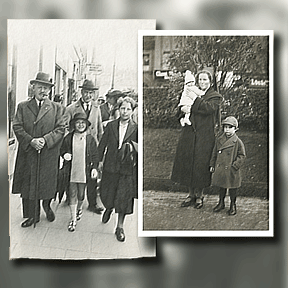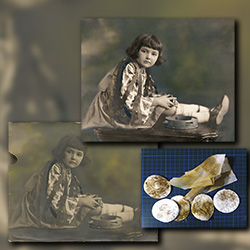RESTORATION, PRESERVATION & ARCHIVING
MENU
PHOTO RESTORATION
Sebastian Wintermute provides a full range of Photo Preservation, Photo Archiving, and Photo Restoration Services, dedicated to protecting and bringing back old photographs that have faded with age or became stained, torn, burned or water damaged.
 Restoration of old photographs, particularly those that cary great personal value, especially if the photographs depict the loved ones who are no longer with us, can be extremely personal and moving experience for many people. Sebastian appreciates, and carefully listens to and follows suggestions and wishes expressed by his clients, and strives to fulfill all of their expectations and instructions.
Restoration of old photographs, particularly those that cary great personal value, especially if the photographs depict the loved ones who are no longer with us, can be extremely personal and moving experience for many people. Sebastian appreciates, and carefully listens to and follows suggestions and wishes expressed by his clients, and strives to fulfill all of their expectations and instructions.
Every restoration project begins with a consultation with a client to assess the damage to a photograph, to discuss the requirements, and to advise a client on techniques, methods, and materials required to restore a photograph and to bring an image back to it’s original appearance.
Factors taken into consideration include photographs physical condition and shape (rolled up photographs will have to be flattened, stains cleaned, creases and tears repaired and reinforced, and missing areas are carefully filled in.), and requirements for a final print of a restored photograph. Based on all those factors and on an expected time frame, an estimate is presented to a client and restoration process begins.
 While discount and offshore photo restoration services rely on use of Photoshop filters and AI image processing, Sebastian feels there is no substitute for artists skills and experience; he carefully retouches each photograph to assure that the restored image perfectly matches the original.
While discount and offshore photo restoration services rely on use of Photoshop filters and AI image processing, Sebastian feels there is no substitute for artists skills and experience; he carefully retouches each photograph to assure that the restored image perfectly matches the original.
Throughout the restoration process, clients are provided with proofs of progress as an informed dialog assures customers satisfaction with the result. After all damage has been repaired and the restored image meets client approval, a test print determines the correct settings and catches any areas that may require additional attention. If the test print is approved, a final print is made and trimmed according to client’s specifications.
Restoration should not be a temporary fix. High quality printing is the key to the longevity of any restored photograph or document and Sebastian believes that only the supplies and materials that are guaranteed to last for generations should be used in this important step. All prints of the restored photographs are made using fine art natural fiber acid free papers and specially formulated inks. The manufacturers of paper and ink guarantee the prints to last for well over 150 years without fading if prints are to be displayed under normal conditions and for over 250 years if prints are kept in a proper environment.
PHOTO PRESERVATION & CONSERVATION
Many of the photographs brought to Sebastian Wintermute Studio for restoration sustained extensive damages caused by improper display, mishandling, or accidents, such as basement flooding or house fire. For such photographs an initial preservation and conservation treatment is required to protect them from future damage and deterioration.Panoramic photographs that were rolled up and stored in that condition for many years, or photographs that sustained water damage from high humidity or an unfortunate basement flood may require humidification and flattening. To prevent cracking of photo emulsion and development of additional tears such photographs have to be places in to a humidification chamber that will slowly re-introduced moisture into the layers of photographs and make them pliable enough for flattening and drying.
 Old photographs for years kept on display became covered with a thick layer of dust, soot, and cigarette smoke residue, making them loses their original colors and vibrancy. The surfaces of such photographs need to be carefully cleaned with special solutions making sure that the photo emulation layer remains intact and undamaged.
Old photographs for years kept on display became covered with a thick layer of dust, soot, and cigarette smoke residue, making them loses their original colors and vibrancy. The surfaces of such photographs need to be carefully cleaned with special solutions making sure that the photo emulation layer remains intact and undamaged.
Other photographs may have fallen victims to children’s mischievous hands and were torn to pieces or were painted over with crayons and magic marker. Torn photographs and photographs with missing areas, in addition to cleaning will require careful mending, piecing together, and filling in of the missing areas, before they can be scanned and digitally retouched to restore an image to its original appearance.
PHOTO SCANNING & DIGITAL ARCHIVING
 Producing a high quality scan is an extremely important step in photo restoration. The quality of the scan determines the quality of the result. While discount photo restoration services use low quality scanners, or require the clients to scan photographs themselves in hope that later whatever imperfections or problems may cause could be fixes with the help of Photoshop or on-line AI services, Sebastian Wintermute utilizes professional equipment and specialized software to ensure that the scans made by him capture even the smallest details or minute color variations needed for high quality photo restoration and art reproduction.
Producing a high quality scan is an extremely important step in photo restoration. The quality of the scan determines the quality of the result. While discount photo restoration services use low quality scanners, or require the clients to scan photographs themselves in hope that later whatever imperfections or problems may cause could be fixes with the help of Photoshop or on-line AI services, Sebastian Wintermute utilizes professional equipment and specialized software to ensure that the scans made by him capture even the smallest details or minute color variations needed for high quality photo restoration and art reproduction.  Prior to scanning the original is cleaned of surface dust and residue. Scans are done at resolution of at least 1200dpi if the image is to be reproduced at its original size. Higher resolution is used if an image is to be enlarged or if capture of small details is required, as it is for fine art reproduction, publication, or digital archiving.
Prior to scanning the original is cleaned of surface dust and residue. Scans are done at resolution of at least 1200dpi if the image is to be reproduced at its original size. Higher resolution is used if an image is to be enlarged or if capture of small details is required, as it is for fine art reproduction, publication, or digital archiving.
Sebastian Wintermute feels there are no substitutes for artists keen eye and attention to smallest details in restoration. Avoiding the use of “dust and scratch filters” that often remove small but exceptionally important details and contribute to an overall loss of image quality, Sebastian manually retouches every image, preventing loss of quality and clarity caused by use of shortcuts and reliance on automated image processing and editing.
 Images intended for digital archives are subjected to extra scrutiny to assure that during restoration and retouching no details were lost, damages, or misinterpreted. Following examination and acceptance by a client, archival images are saved at a maximum allowed resolution in lossless digital formats. Special digital storage media, such as Gold Archival Grade DVDs designed to last for over 100 years when properly stored, are used to record and deliver the images to clients.
Images intended for digital archives are subjected to extra scrutiny to assure that during restoration and retouching no details were lost, damages, or misinterpreted. Following examination and acceptance by a client, archival images are saved at a maximum allowed resolution in lossless digital formats. Special digital storage media, such as Gold Archival Grade DVDs designed to last for over 100 years when properly stored, are used to record and deliver the images to clients.